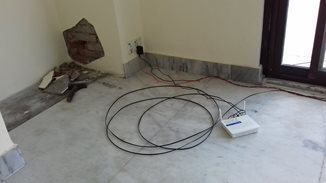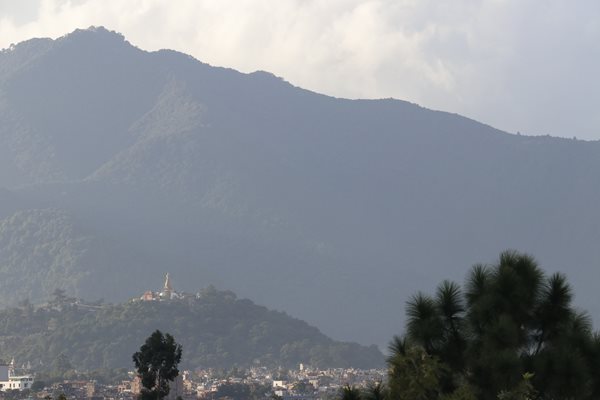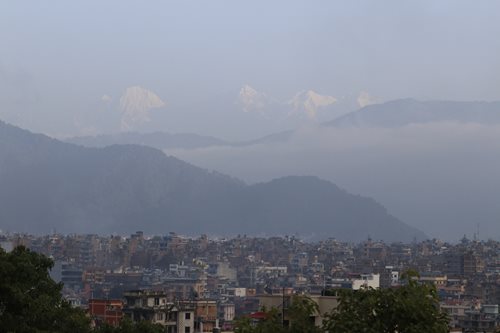How do you find somewhere to live in an urban sprawl with no estate agents, few road names, no road signs and absolutely no house numbers or real addresses; where there are few landlines and listed mobile phone numbers never seem to raise anyone.
Ram was the solution, a charming chap in his late thirties with a friendly demeanour, a comfortable paunch and a tiny notebook (3x4 inches) containing landlords’ contact details. He picked me up from the hotel, ineptly I climbed aboard his scooter and we wobbled and weaved through frightening thoroughfares, navigating potholed lanes and down bumpy alleyways. He took me to a grand 15-storey apartment block (where from the 12
th floor I wondered about the next earthquake), to decadent serviced marble flats where breakfasts are served on the roof terrace, to a five-bedroomed mansion with a sauna, to several rather gloomy traditional brick-built houses smelling of curry, to interesting dwellings perched on hillsides, with bedrooms below reception rooms. Then finally we found a place we thought we’d be able to call home.
Like many of the places expatriates rent, it is a bit of a marble palace but a Nepali family live downstairs and there is a modest garden. We can see out to the rim of the Kathmandu Valley, to Haatiban (elephant forest) on one side, the gleaming golden stupa of Swayambhu (the ‘monkey temple’) on another, and from the elevated water tanks above the roof terrace we should be able to see the Himalayas on a clear day.
The flat is totally unfurnished so whereas many normal domesticated women might relish the opportunity to shop and set up a home entirely to her own taste, I’m not so enthusiastic, even if it does mean I’m having to practice my faltering Nepali as there is plenty of negotiation and haggling. This always turns out to be a giggle, as my numerical brain is always a bit slow and it is slowed further by translating from Nepali and also converting from rupees to pounds and then there is a discount for no particularly good reason…. I’m easily discombobulated. Even in department stores prices don’t ever seem to be completely fixed but everyone is very patient and encouraging.
Our new landlord, Prakat, is a likeable Newar and we quickly bonded on being of similar age and he speaks a lot of the burdens life has laid on him. He is restless and his brow is set into a permanent furrows of worry but that doesn’t stop him laughing a great deal. I say he is likeable although he is terribly racist. He spoke of not wanting to rent to Indians (their cooking stinks the house out), Chinese (they keep water running while cleaning their teeth) or Africans (not very clean) or people with children (they break things), or in fact most people really. Fortunately, he thinks us worthy of his house. Even so we’ve had plenty of negotiations over what he will and won’t provide.
Discussions were lengthy, stretched over many days and gave us opportunities to complain about government, bureaucratic processes, tax and many other subjects. He told me how stressful it is moving house and that I must work slowly otherwise I'll grow thin and ill.
There is always plenty to discuss as there are very few givens in Nepal. Take water, for example. Twice or thrice a week the government pumps water to homes, and today is one of those days. I could tell because as I cycled out this morning, there were multiple new springs that had appeared, issuing tap water onto the road, and at our new apartment there a trickle of water emerging from a pipe in the garden. I guess the water was pumped for about two hours. For people with money, the solution to this valley-wide water shortage is to pay for tankers of water to be brought to the house once a week or so. The tanker driver visits springs at the valley edge and fills tanks that every home has.
An alternative is hand-pumping from groundwater but that is usually contaminated and smelly – too smelly and coloured in some parts of Kathmandu even to be useful for washing and laundry. When we lived here 19 years ago, the water supply problem was about to be solved, by pumping water from the Melemchi River through a tunnel in the mountains, but people still talk about the water that will soon be coming from the Melemchi scheme. City streets have been dug up and new pipes have been installed in readiness. It remains to be seen when or whether the water will arrive.
The landlord agreed to install wifi for us and yesterday a man from WorldLink came to install the modem. He started work at the spaghetti of wires on a post outside the house and brought one wire to the terrace on the first floor. He needed to make a hole in the fabric of the building to bring the wire inside and so produced a power drill and set to work.

The result were dinner-plate-sized craters outside and also in the freshly painted plasterwork inside. The landlord paced about with his hand over his mouth looking like he was restraining himself from shouting at the workman. I even looked like he was about to cry. Meanwhile, his son just laughed, although I’m uncertain whether this was at the mess or his fathers’ distress. Nepalis laugh a lot – sometimes when there is nothing else to be done. All was not as bad as it first seemed though. The workman produced cement from somewhere and the damaged area will be ready for repainting soon. Meanwhile a carpenter is applying a small sledgehammer to some metal shelves to make them fit into kitchen cupboards for which they are too large. And now he has gone on to hit a window that sticks (I thought it needed planning) with his hammer. I’m surprised the pane has survived this long.
Tomorrow the plumber will come, and I think he’ll need to smash another hole in the fabric of the house so that we can install a washing machine. I have a horrible feeling there will be a bit more decorating that’ll need to be done after that visit too.
 |
| The golden stupa at Swayambhu, with the 2000m valley rim behind |
 |
| Looking north across Kathmandu to Ganesh himal - an early morning delight |